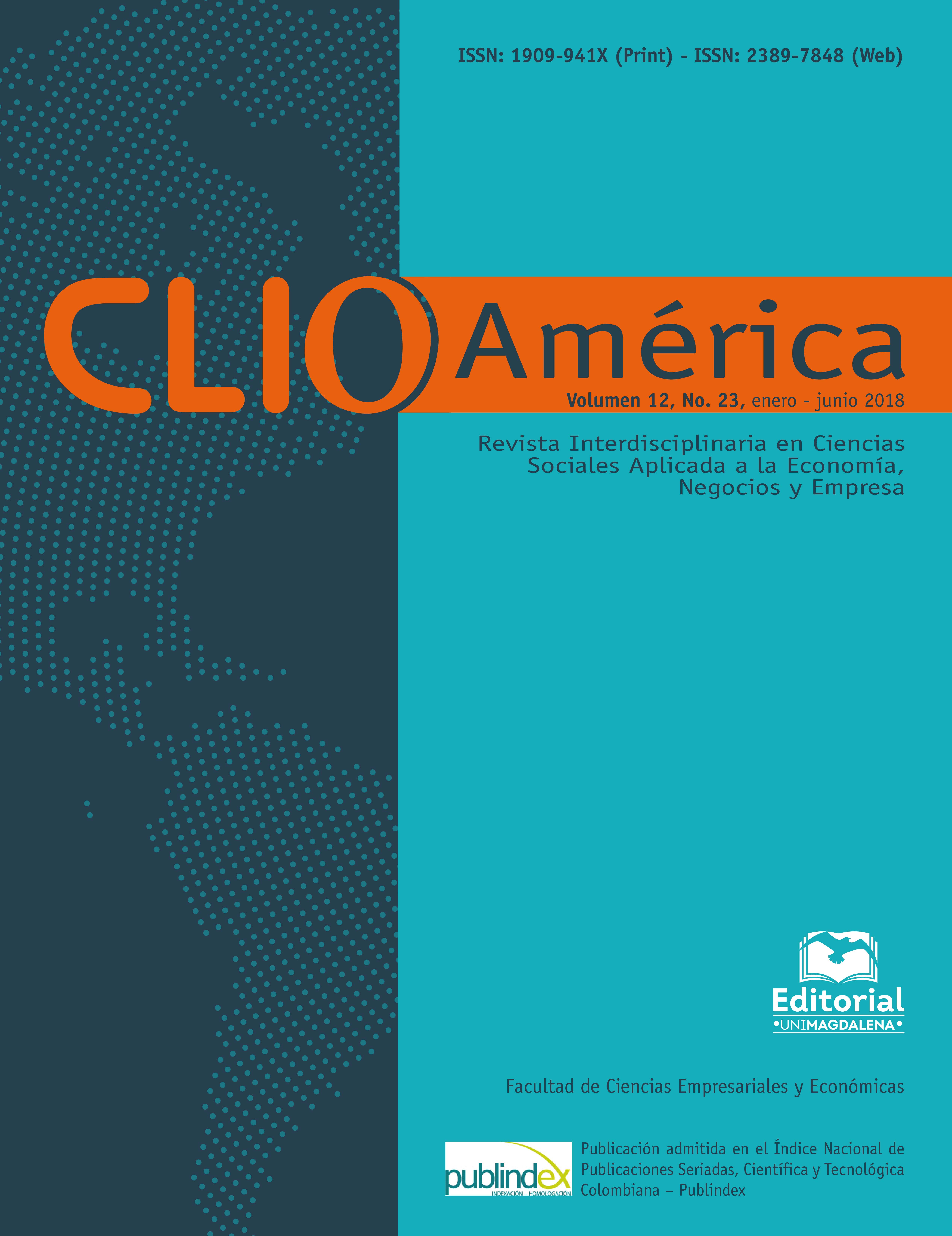Abstract
The perception of poverty in Colombia allows to complement the diagnoses on welfare in the country, in order to ensure its economic and social development. For this reason, this article analyzes the incidence of individual characteristics and environment on the perceptions of poverty reported by Colombians in 2003 and 2016. For this, two models are estimated: a probit and a generalized ordered logit, using the National Quality of Life Survey for both years. It can be concluded that monetary income continues to be important to face the feeling of poverty, although its contribution has lost its weight, and other factors have been positioned, such as a good state of health, access to new technologies and solutions to vehicular congestion, among others. Finally, this study shows that there are factors that continue to be necessary to reduce people’s perception of poverty but have not been sufficient to change their perception.References
Alem, Y., Köhlin, G. y Stage, J. (2014). The persistence of subjective poverty in urban Ethiopia. World Development, 56, 51–61. http://doi.org/10.1016/j.worlddev.2013.10.017
Arroyo, J. y Ruiz, D. (2017). Pobreza subjetiva y reconocimiento étnico en Colombia: análisis para principales regiones. Sociedad Y Territorio, 17(53), 87–113.
Ayllón, S. y Fusco, A. (2017). Are income poverty and perceptions of financial difficulties dynamically interrelated? Journal of Economic Psychology, 61, 103–114. http://doi.org/10.1016/j.joep.2017.03.008
Bonilla, R. (2011). Apertura y reprimarización de la economía colombiana. Revista Nueva Sociedad, 231, 43–65.
Departamento Administrativo Nacional de Estadística – (DANE). (2003). Encuesta Nacional de Calidad de Vida -ECV- 2003. Recuperado de https://www.dane.gov.co/index.php/estadisticas-por-tema/salud/calidad-de-vida-ecv/encuesta-de-calidad-de-vida-2003
Departamento Administrativo Nacional de Estadística – (DANE). (2016). Encuesta Nacional de Calidad de Vida -ECV- 2016. Recuperado de http://www.dane.gov.co/index.php/estadisticas-por-tema/salud/calidad-de-vida-ecv/encuesta-nacional-de-calidad-de-vida-ecv-2016
Departamento Nacional de Planeación – (DNP). (2016). Departamento Nacional de Planeación revela primer diagnóstico de felicidad para Colombia. Recuperado de https://www.dnp.gov.co/Paginas/DNP%20revela%20primer%20diagn%C3%B3stico%20de%20felicidad%20para%20Colombia.aspx
Departamento Nacional de Planeación – (DNP). (2006). Hacia una Colombia equitativa e incluyente. Recuperado de https://colaboracion.dnp.gov.co/CDT/Desarrollo%20Social/Informe%20Hacia%20una%20Colombia%20Equitativa.pdf
Goedhart, T. y Halberstadt, V., Kapteyn, A. y Van Praag, B. (1977). The poverty line: concept and measurement. Journal of Human Resources, 12(4), 503–520. doi: http://doi.org/10.2307/145372
Gujarati, D. (2003). Basic Econometrics. New York, Estados Unidos: McGraw-Hill.
Kotan, M. (2010). Freedom or happiness? Agency and subjective well-being in the capability approach. Journal of Socio-Economics, 39(3), 369–375. doi: http://doi.org/10.1016/j.socec.2009.11.003
Liu, Z. y Shang, Q. (2012). Individual well-being in urban China: The role of income expectations. China Economic Review, 23(4), 833–849. doi: http://doi.org/10.1016/j.chieco.2012.04.004
Lora, E. (2011). Cómo los indicadores subjetivos pueden contribuir a la medición del progreso de las sociedades. En M. Rojas (Ed.), La medición del progreso y del bienestar Propuesta desde América Latina (pp. 41–57). México D.F., México: Foro Consultivo Científico y Tecnológico.
Moscote, O. y Rincon, W. (2012). Modelo Logit y Probit: un caso de aplicación. Comunicaciones En Estadística, 5(2), 123-133.
Palomar, J. (2004). Tracking historical papers and their citations. European Science Editing, 38(2), 35–37.
Pedraza, L., Villamizar, A. y Ortiz, Z. (2015). Desafíos del proceso de construcción de paz para la Policía Nacional de Colombia. Revista Criminalidad, 57(3), 135–148.
Pinzón, L. F. (2017). Factores asociados a la pobreza subjetiva en Colombia: un estudio desde el enfoque de las capacidades y la economía de la felicidad. Revista Desarrollo y Sociedad, 98(78), 11–57.
Piñeros, L. y González, Á. (2015). La pobreza subjetiva y sus determinantes: una aproximación empírica al caso colombiano. Documentos de Trabajo, 26, 1–40.
Pradhan, M. y Ravallion, M. (2000). Measuring Poverty Using Qualitative Perceptions of Consumption Adequacy. The Review of Economics and Statistics, 82(3), 462-471.
Ramírez, O. M. (2013). La paz sin engaños: Estrategias de solución para el conflicto colombiano. Bogotá, Colombia: Universidad de La Salle.
Ravallion, M. (1998). Poverty lines in theory and practice. Recuperado de http://documents.worldbank.org/curated/en/916871468766156239/Poverty-lines-in-theory-and-practice
Rojas, M. (2011). Más allá del ingreso: progreso y bienestar subjetivo. En M. Rojas (Ed.), La medición del progreso y del bienestar Propuesta desde América Latina (pp. 29–39). México D.F., México: Foro Consultivo Científico y Tecnológico.
Rossi, P. H. y Weber, E. (1996). The social benefits of homeownership: empirical evidence from national surveys. Housing Policy Debate, 7(1), 1–36.
Suárez, M., Guardiola, J. y González-Gómez, F. (2016). Do Pro-environmental Behaviors and Awareness Contribute to Improve Subjective Well-being? Applied Research in Quality of Life, 11(2), 429–444. doi: https://doi.org/10.1007/s11482-014-9372-9
Tobasura, E. M. y Casas, J. A. (2017). La línea de pobreza subjetiva para Tunja, Colombia 2015. Apuntes del CENES, 36(64), 253–282. https://doi.org/10.19053/01203053.v36.n64.2017.6548
Van Praag, B. y Ferrer-i-Carbonell, A. (2011). Happiness Economics: A New Road to Measuring and Comparing Happiness. Foundations and Trends in Microeconomics, 6(1), 1–97. doi: https://doi.org/10.1561/0700000026
Velásquez, L. (2011). Dimensiones de la pobreza en Caldas y factores asociados. RegiónEs2, 6(1), 71–102.
Wagle, U. R. (2006). Economic Inequality in Kathmandu: A Multi-Indicator Perspective. Himalayan Journal of Development and Democracy, 1(1), 30.

This work is licensed under a Creative Commons Attribution-NonCommercial-ShareAlike 4.0 International License.


